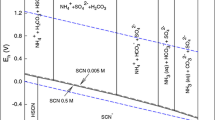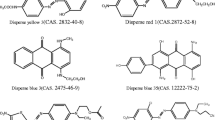Abstract
The methylene blue method has been widely used for analysis of sulfide for more than 100 years. Direct measurement of methylene blue at nanomolar concentrations is impossible without a preconcentration step, however. In this study the response of LC–MS with electrospray ionization (ESI) to methylene blue was evaluated. HPLC with simple isocratic elution was followed by ESI-MS quantification, which was compared with traditional UV–visible detection. The limit of detection for sulfide was approximately 50 ng L−1, or 1.5 nmol L−1. Analysis time was substantially reduced by use of isocratic elution. Interfering compounds produced by side reactions can be eliminated by use of the mass filter. A polysulfide sample was also analyzed to determine which products are formed and whether or not polysulfides react stoichiometrically with methylene blue reagent. It seems that polysulfides do not react quantitatively with methylene blue and so cannot be quantified reliably by use of this method.






Similar content being viewed by others
References
Stumm W, Morgan JJ (1995) Aquatic chemistry, 3rd edn. Wiley, New York
Schwarzenbach G, Widmer M (1963) Helv Chim Acta 46:2613–2628
Fabbri D, Locatelli C, Snape CE, Tarabusi S (2001) J Environ Monit 3:483–486
Jay JA, Morel FMM, Hemond HF (2000) Environ Sci Technol 34:2196–2200
Paquette KE, Helz GR (1997) Environ Sci Technol 31:2148–2153
Hurley JP, Krabbenhoft DP, Babiarz CL, Andren AW (1994) Cycling of mercury across sediment–water interface in seepage lakes. In: Baker LA (ed) Environmental chemistry of lakes and reservoirs. American Chemical Society, Washington, DC, pp 425–449
Ullrich SM, Tanton TW, Abdrashitova SA (2001) Crit Rev Environ Sci Technol 31:241–293
Ravichandran M (2004) Chemosphere 55:319–331
Haitzer M, Aiken GR, Ryan JN (2002) Environ Sci Technol 36:3564–3570
Craig PJ, Moreton PA (1986) Water Res 20:1118–1119
Hintelmann H, Welbourn PM, Evans RD (1997) Environ Sci Technol 31:489–495
Lawrence NSDJ, Compton RG (2000) Talanta 52:771–784
Brower H, Murphy TP (1994) Environ Toxicol Chem 13:1273–1275
Ehman DL (1976) Anal Chem 48:918–920
Fischer E (1883) Chem Ber 26:2234–2236
Cline JD (1969) Limnol Oceanogr 14:454–458
Hassan SSM, Marzouk SAM, Sayour HEM (2002) Anal Chim Acta 446:47–55
Tang D, Santchi PH (2000) J Chromatogr A 883:305–309
Mylon SE, Benoit G (2001) Environ Sci Technol 35:4544–4548
Nielsen AH, Vollertsen J, Hvitved-Jacobsen T (2003) Environ Sci Technol 37:3853–3858
Millero FJ (2001) Physical chemistry of natural waters. Wiley–Interscience, pp 582–612
Luther GW, Theberge SM, Rickard DT (1999) Geochim Cosmochim Acta 63:3159–3169
Benoit JM, Gilmour CC, Mason RP, Heyes A (1999) Environ Sci Technol 33:951–957
Bowles KC, Ernste MJ, Kramer JR (2003) Anal Chim Acta 447:113–124
Harris DC (1996) Quantitative chemical analysis, 4th edn. Freeman, New York, pp 439–445
Van Berkel GJ, Sanchez AD, Quirke ME (2002) Anal Chem 74:6216–6223
Scheifers SM, Verma S, Cooks R (1983) Anal Chem 55:2260–2266
Keith LH, Crummett W, Deegan J, Libby RA, Taylor JK, Wentler G (1983) Anal Chem 55:2210–2218
Acknowledgements
This research was funded by an NSERC Discovery grant to Holger Hintelmann. We would like to acknowledge the contribution of Olivier Clarisse and Delphine Foucher for their help with sulfide analysis, and Chris Stadey and Ray March for their assistance with the Quattro LC–MS.
Author information
Authors and Affiliations
Corresponding author
Rights and permissions
About this article
Cite this article
Small, J.M., Hintelmann, H. Methylene blue derivatization then LC–MS analysis for measurement of trace levels of sulfide in aquatic samples. Anal Bioanal Chem 387, 2881–2886 (2007). https://doi.org/10.1007/s00216-007-1140-3
Received:
Revised:
Accepted:
Published:
Issue Date:
DOI: https://doi.org/10.1007/s00216-007-1140-3




